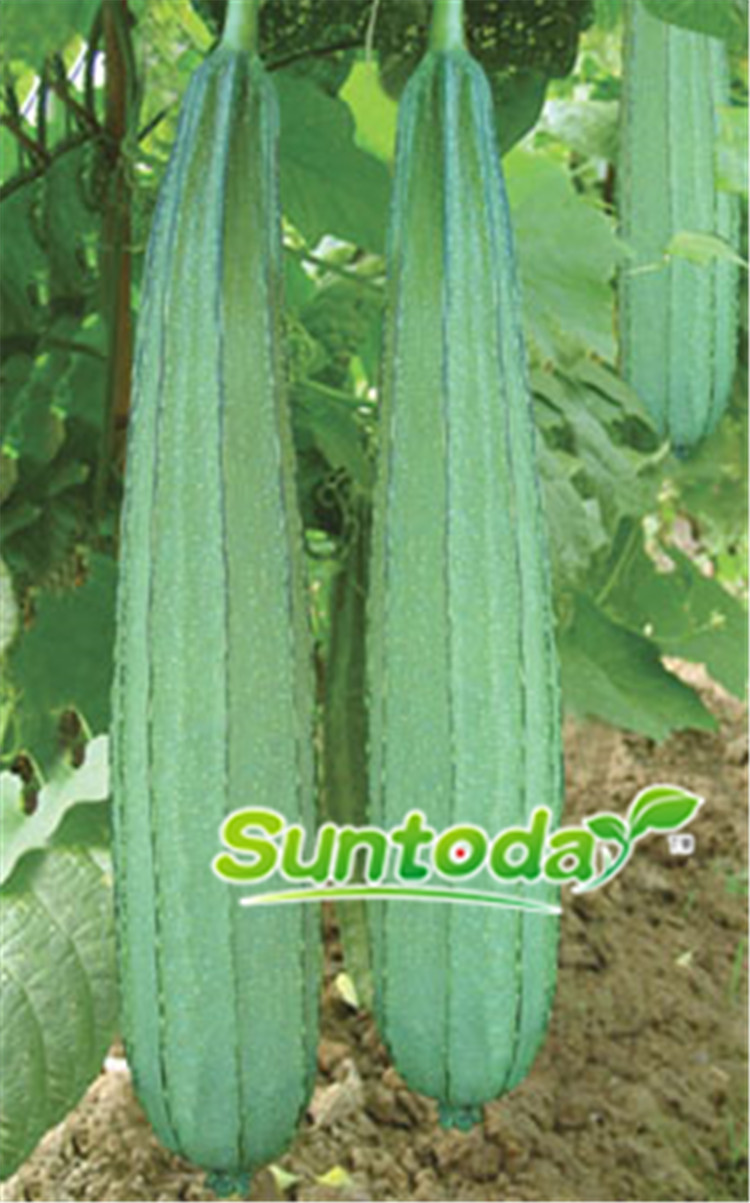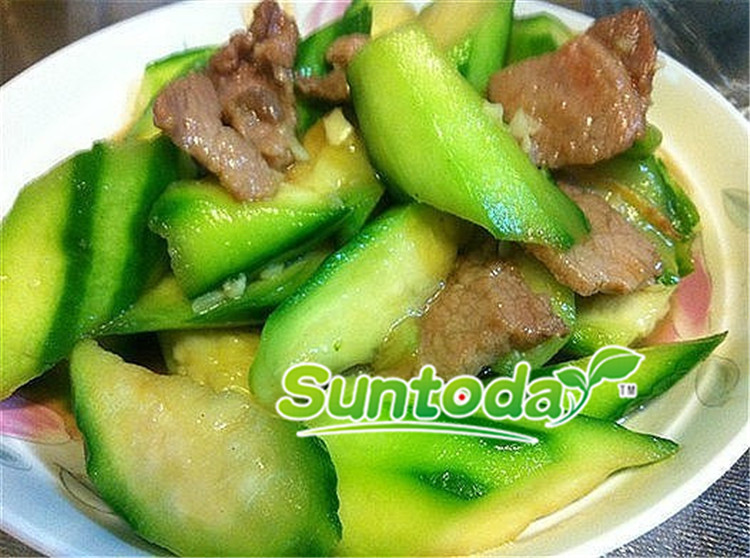Cultivation Guide for Luffa Variety Series
Time:2016-09-10 Click:
Cultivation Guide for Luffa Variety Series
The luffa is strongly resistible, productive, high quality and easy cultivating varieties. They are fond of fertilizer and water. For Spring sowing, culture seedlings in Mar., and covered with tunnel, entering market in Jun. For Summer sowing, cultrue seedlings from middle Apr. to early May or derectly sowing, entering market from Jul. to Sep. For Autumn sowing, cultrue seedlings in Jul., or derectly sowing, and enter market in middle Sept.1, Sowing and Culture of Seedling
1.1, Seedbed Preparation
Choose pollution-free rice field soil that is fertile and loosen,and burned soil that is sieved, to mix by 7:3 ratio, and each CBM(cubic meter) add in 1500g of calcium, magnesium and phosphate, and 500g of urea, mix uniformly to make the nutrient soil. Then pack into the nutirent bag which is 10cm by 10cm by 12-15cm, make it weighting about 0.75kg. Lay the nutrient bags which are packed with soil on the prepared seedbed, fill the gaps between bags with fine soil. Earth up around the edges to make the seedling ridge. Spray the bed surface moist with 500 times of 50% Dixon WP, dry it and then cover with films.1.2, Seeds Treatment
In order to improve the seed germination rate and potential, and kill bacteria or virus brought by seeds, it was emphasized to go through seed treatment. First of all, sun the seeds on the strong sunlight for 3-5h, and then soak the seeds in 50-55℃ hot water for 10min, stir constantly to make the heating evenly. And then soak seeds in clear water at normal temperature for 18-24h. After that, soak seeds into 500 times of 50% carbendazim WP or 0.1% potassium permanganate solution for 30-50min, then wash by clear water and dry for broadcast.
1.3, Sowing
When sowing, lie the soaked seeds on the middle of the nutrient bags, one in each bag, and irrigate throughly, then cover with a layer of thick soil which is 0.8-1cm thick. Cover a mulching film on the soil, and insert bamboo tunnel, then cover with tunnle film to keep warm and moist. Under the normal climate condition, the seeds will sprout in 15 days, and trimly in 20 days. When the seedlings grow out 4-5 pieces of leaves, transplant them into the field.1.4, Seedling Management
Around the coming up of seedling, the tunnel temperature should maitain in 25-28 degree centigrade in the daytime and 12-15 degree centigrade at night, and the seedbed soil should keep moist, to meet the demand of water for seed germination and seedling growth, and promote seedling germination and growth. When the seedlings come up, remove the mulching film. When the first main leaf grows out, spray 800 times of 72% previcur aqua, or 3000 times of 99% hymexazol WP, to prevent and control damping-off disease. In the 2-3 leaf stage, manure 10% thin human excreta for nutritional support.2, Field Preparation and Base Manure
2.1, File Selection
It’s better to select the field which has thick topsoil, fertile soil conditions, convenient transportation and well drainage, and is not gourd cropping beforet time.2.2, Clearing, Ploughing and Soil Sunning of Field
15-20 days before transplanting, clear away the pre-stubble and the weeds in the ditches. Then, choose a sunny day to plough the fiel deeply by about 30-35cm, and sun the soil.2.3, Soil Preparation and Base manure Supply
7-10 days before transplanting, break up the clods into pieces, rake the field smooth and fine, and then manure base manure. For each acre, broadcast 9000-12000kg of finished farmyard manure, 300kg of 45% S-NPK potassium sulphate compound fertilier, and 600kg of calces. And then prepare the soil to make ridge which is 2m wide, with ditches in 30cm wide by 35cm deep.3, Field Management

3.1, Timely Transplanting and Resonable Dense Planting
In mid March, when comes to the 4-5 leaf stage and the seedling is about 30cm high, start to transplant. For plant setting, transplant one row one plant in the middle, with planting distance in 1-1.2cm. Every 667 square meters transplant 600-800 plants. Supply root setting water when transplanting.3.2, Building Shelf and Leading Vine
When the vine grows to about 30cm long, insert pole near the seedling for the chief vine to climb. When the vine grows to 60-70cm long, the shed can be built. Use moso bamboo or timber pile to stake in every 3m, and then connect with thick iron wire, to build up a level shelf which is 2.2-2.5m high. On the top of shelf, use knit belt or nylon rope to roll a net 20cm by 25cm, to hold the vines on the shelf so as to lead vines.3.3, Pruning and Fruit Thinning
3.3.1, PruningBefore the vine grows onto shelf, keep the chief bud and wipe out the side buds. After led on shelf, wipe off the over-dense side branches, overlap weak branches, and sick branch, and also wipe off the excrescent male flower, so as to reduce nutrient consume.
3.3.2, Leaf Picking
When comes to the full bearing period, timely wipe off the old, yellow, sick and over-dense leaves in low layer, so as to strengthen the ventilation and illumination, reduce the rate of diseases and pests attacking, and improve quality and quantity.
3.3.3, Fruit Thinning
Timely thinhing off the abnormal fruits and mummy fruits, and the small weak young melons which are over setting. Let the young melons hang below the shelf naturally.
3.4, Scientific Fertilization and Reasonable Irrigation
3.4.1, FertilizationHold the priciples below. Supply adequate base manure, lightly in early, heavily in middle and additionally in late, properly top dressing on leaf. After the survival from transplanting, supply 3000kg of 20% thin human excreta per acre as the seedling raising manure. Just when the vines climb onto the top of the shelf, along with cultivation, broadcast 300kg of 48% S-NPK on the plot surface per acre before shallow to middle ploughing. Entering the picking stage, after each period of picking, top dressing once in every about 10-15 days, by waterly fertilize 120-150kg of S-NPK compound fertilizer per acre. In the full bearing period, along with preventation and control of diseases and pests, use 300-500 times of 0.2% monopotassium phosphate, plant amino acid, or hunic acid to spray on the leaves.
3.4.2, Moisture
The luffa is fond of moisture and tolerent to fertilizer and water. In the early growth period, give priority to keep the the soil moisture. In the prosper growth period, the growth quantity of leaf and vine is huge, the requirement of water is abundant. In the full bearing period, as the weather is hot and drought, irrigate in time to support water, to keep shallow water layer in the bottom of the ditches.
4, Prevention and Control of Diseases and Pests

The diseases and pests: melon fly, whitefly, aphids, leaf miner, predator stink bug, and downy mildew, epidemic disease, virus disease, powdery mildew and anthracnose diseases. For the pests, choose 2000 times of 20% Permethrin EC, 1000-1500 times of 40% Abamectin·Acetamiprid EC, 1000 times of 20% (0.2%abamectin+19.8%monsultap ME ) solution, or 1000-1500 times of 40% (15%chlorpyrifos+25%malathion) EC to supply for control. For disease, spray 800-1000 times of 72% Dupont or 69% mancozeb·dimethomorph WP, or 1500 times of 62% myclobutanil·mancozebWP for control.

